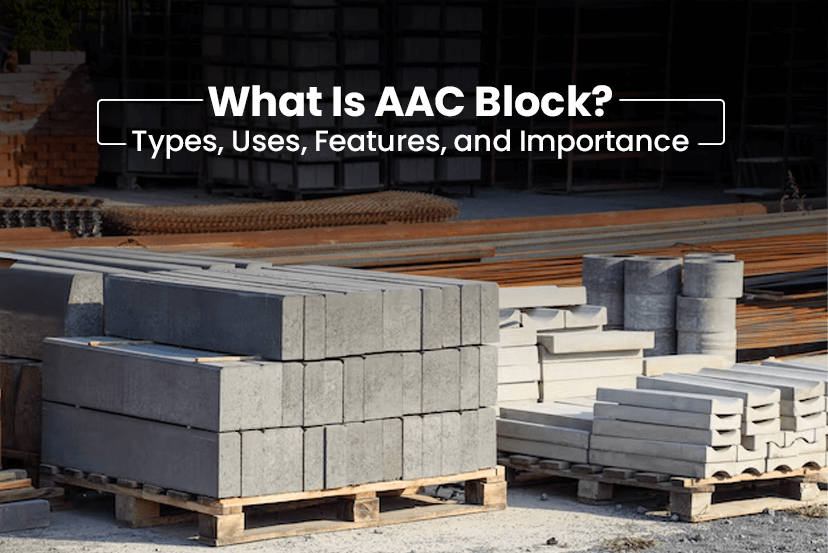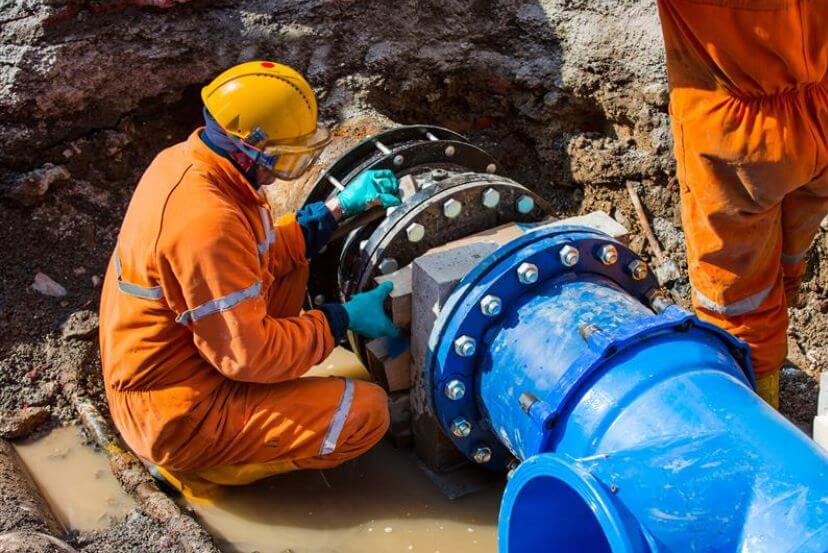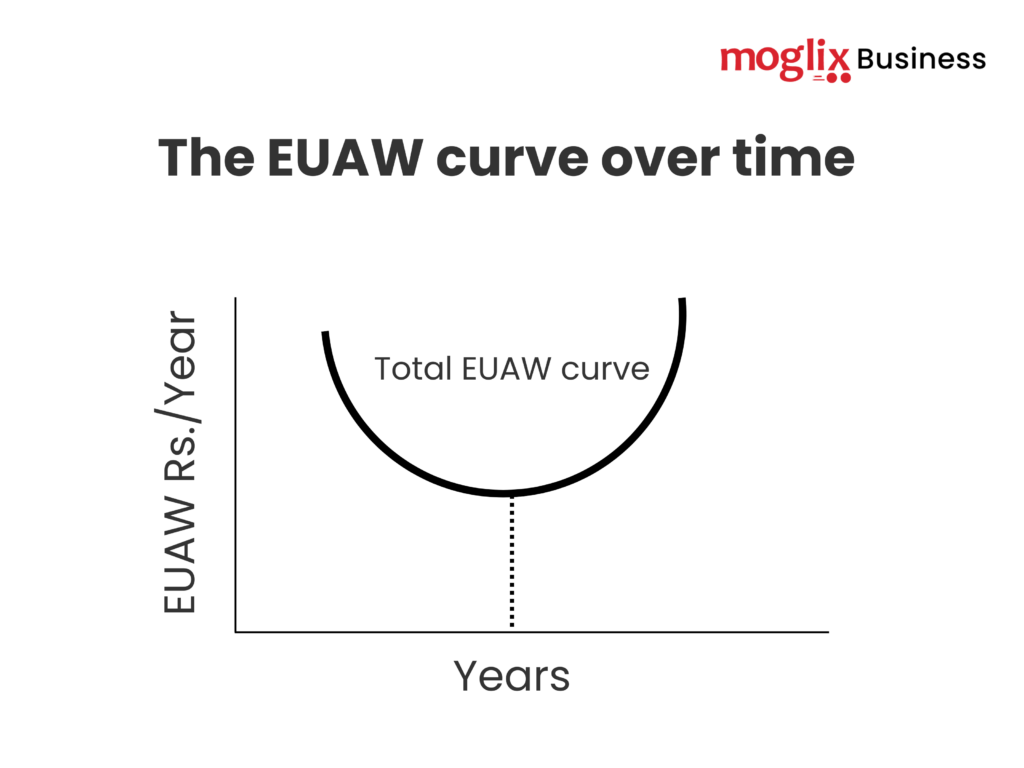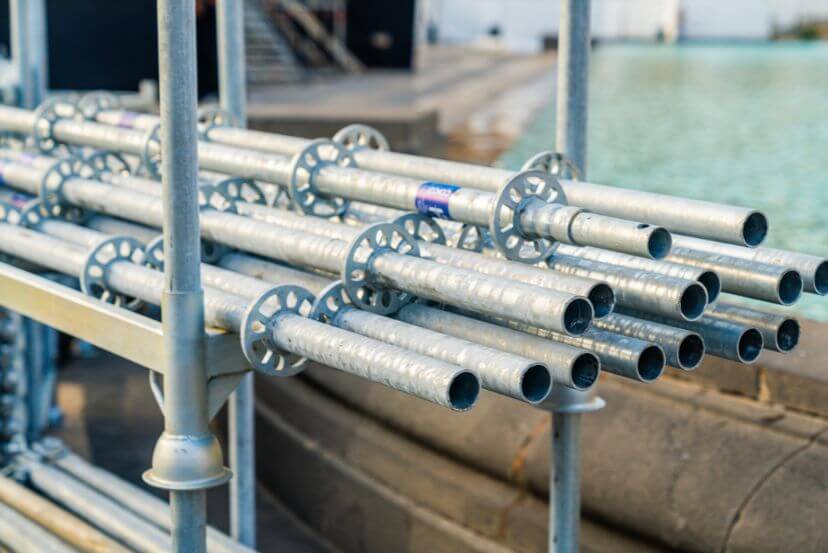What Is AAC Block? Types, Uses, Features, and Importance

What Is AAC Block? Types, Uses, Features, and Importance
In modern construction, balancing strength, cost, speed, and sustainability is crucial. One building material that meets all these requirements is the AAC block. Widely used in residential, commercial, and industrial projects, AAC blocks have transformed the way walls are constructed in India and across the globe. This blog explains what AAC blocks are, their types, uses, features, and importance, helping you decide whether they are right for your next construction project.
What does an AAC Block mean?
AAC block full form is Autoclaved Aerated Concrete block, which is a lightweight precast building material made from cement, lime, fly ash, sand, water, and an expanding agent. Through a controlled manufacturing process and high-pressure steam curing (autoclaving), AAC blocks develop a porous, honeycomb-like structure that gives them high strength while keeping them extremely lightweight. Compared to traditional red bricks, AAC blocks are larger, lighter, more uniform, and offer better thermal and acoustic insulation.
How AAC Blocks Are Made?
- Raw materials such as cement, fly ash, lime, and sand are mixed.
- Aluminum powder is added to create air bubbles through a chemical reaction.
- The mixture expands and is cut into blocks or panels.
- The blocks are cured in an autoclave under high pressure and temperature.
- Final products are tested for strength, density, and quality.
Understand The Various Types Of AAC Blocks
AAC blocks are categorized based on density, size, and application:
1. Load-Bearing AAC Blocks
- Higher density and compressive strength
- Suitable for low-rise buildings
- Reduce the overall dead load on the structure
2. Non-Load-Bearing AAC Blocks
- Lower density
- Used for partition walls and infill walls
- Ideal for high-rise buildings with RCC frames
3. AAC Blocks Based on Density
- Low Density (400–500 kg/m³): Excellent insulation, used for partitions
- Medium Density (550–650 kg/m³): Commonly used for residential and commercial walls
- High Density (700 kg/m³ and above): Used where higher strength is required
4. AAC Panels (Advanced Type)
- Large, reinforced AAC panels
- Used for flooring, roofing, and cladding
- Speed up construction significantly
What Are The Uses Of AAC Blocks
AAC blocks are highly versatile and are used across various construction segments:
- Residential buildings – houses, apartments, villas
- Commercial structures – offices, malls, hotels
- Industrial buildings – warehouses, factories
- High-rise buildings – partition and infill walls
- Boundary walls and compound walls
- Fire-resistant walls and acoustic barriers
Have An Eye On The Key Features Of AAC Blocks
1. Lightweight Construction
AAC blocks weigh nearly one-third of traditional bricks, reducing structural load and foundation cost.
2. High Compressive Strength
Despite being light, AAC blocks offer sufficient strength for both load-bearing and non-load-bearing applications.
3. Excellent Thermal Insulation
The air pores in AAC blocks provide superior insulation, keeping buildings cooler in summer and warmer in winter.
4. Sound Insulation
AAC blocks effectively reduce noise, making them ideal for residential and commercial spaces.
5. Fire Resistance
AAC blocks are non-combustible and can withstand high temperatures for up to 4–6 hours, enhancing building safety.
6. Eco-Friendly Material
Manufactured using fly ash, a byproduct of thermal power plants, AAC blocks support sustainable construction.
7. Precise Dimensions
Uniform size and smooth surfaces reduce mortar usage and plaster thickness.
8. Faster Construction
Larger block size and easy handling speed up masonry work and reduce labor costs.
What Is an AAC Block Price Based on Sizes?
Here’s a quick breakdown of approximate per-piece rates for different thicknesses of AAC block (Autoclaved Aerated Concrete block) in India, though actual price may vary depending on region, brand, order quantity, and delivery charges:
- 4-inch AAC block: around ₹ 45 – ₹ 55 per piece.
- 6-inch AAC block: roughly ₹ 65 – ₹ 85 per piece.
- 8-inch AAC block: approximately ₹ 85 – ₹ 110 per piece.
Importance of AAC Blocks in Modern Construction
1. Cost Efficiency
Although AAC blocks may have a higher initial cost, they reduce expenses related to:
- Cement and mortar
- Steel consumption
- Plaster thickness
- Construction time
This makes the overall project more economical.
2. Structural Safety
Lower dead weight minimizes seismic impact, making AAC blocks suitable for earthquake-prone areas.
3. Energy Efficiency
Better insulation means reduced dependence on air conditioners and heaters, lowering long-term energy costs.
4. Sustainable Building Solution
AAC blocks contribute to green building certifications and help reduce carbon footprint.
5. Long-Term Durability
AAC blocks resist termites, mold, and moisture-related damage, ensuring a longer lifespan of structures.
AAC Blocks vs Red Bricks (Quick Comparison)
| Feature | AAC Blocks | Red Bricks |
| Weight | Very light | Heavy |
| Size | Large and uniform | Small and uneven |
| Thermal Insulation | Excellent | Limited |
| Construction Speed | Fast | Slow |
| Material Wastage | Minimal | High |
| Eco-Friendliness | High | Moderate |
Conclusion
AAC blocks have emerged as smart, sustainable, and cost-effective building materials for modern construction. With advantages like lightweight structure, excellent insulation, high fire resistance, and eco-friendliness, AAC blocks outperform traditional bricks in almost every aspect. Whether you are constructing a home, commercial complex, or industrial facility, you can buy AAC blocks at Moglix Business in bulk from reputed and trusted brands that offer long-term benefits in terms of safety, cost savings, and energy efficiency.
Reasons Why You Should Rent Hydraulic Breakers Instead of Purchasing Them: A Wise Selection for Construction Efforts

Reasons Why You Should Rent Hydraulic Breakers Instead of Purchasing Them: A Wise Selection for Construction Efforts
Hydraulic Breakers are highly recommended for demolition, construction works and excavating activities due to their capability and effectiveness. These machines efficiently and effectively demolish materials such as concrete, rocks, asphalt and other hard materials with the use of their highly impactful force. However, the decision on whether to purchase or rent hydraulic breakers can either lessen the costs of the construction project or greatly overspend it as well as the time and operational mobility of the project as a whole.
Due to the flexibility and maintenance offered, the latest technology, and immense cost savings, construction companies are favoring the approach of renting hydraulic breakers. This works especially well when trying to meet the ever-growing pressure on construction costs.
This blog highlights the core reasons as to why renting the machine is more sensible compared to purchasing it, the major advantages, as well as the best ways to ensure the efficiency and return on investment of these machines is maximized.
The Importance of Hydraulic Breakers in Construction Work
Hydraulic Breakers are frequently called breaker hammers and are part of heavy construction equipment. They are customarily fitted on excavators as well as backhoes. They use hydraulic pressure to drive a piston, which then makes extremely rapid and repetitive blows onto a surface to shatter and break it apart. They are regularly used for:
- Breaking and demolishing concrete buildings and structures.
- Quarrying and other forms of rock excavation.
- Fixing and maintaining roads, including breaking, asphalting and repairing.
- Performing trench and foundation work.
Like most heavy-duty construction tools, hydraulic breakers are set apart in functionality and design and are equally critical to construction work that requires a heavy hand and an abundant amount of power, raw strength, and utmost precision to details.
The Disadvantages Of Buying Hydraulic Breakers
While it might seem positive to purchase a hydraulic breaker, considering the demolition or excavation work is done frequently, owning a hydraulic breaker does come with several drawbacks. These include:
The Costs Of Buying The Equipment
Like most machines, and equipment, the cost of a hydraulic breaker is extremely high and usually goes into the lakhs. Based on their size and the power that they can generate, the cost usually goes higher. This could be an enormous burden for a smaller company that isn’t as accessible with finances.
The Costs Of Maintenance and Repair
Purchasing heavy equipment means that it is the sole responsibility of the owner to ensure that regular maintenance, repair work and replacement of spare parts is done to the equipment. These costs can pile up and often cause significant delays to the work that is required to be done.
Depreciation and Storage Issues
All things vertical have a tendency and tendency to gobble depreciation. It’s complicated and it’s added to the ‘Column Debits’ of hydraulic breakers depreciating the most and the fastest. On top of that there’s the matter of placing them, along with sabotage wrist straps, between projects. Whose oxidization of reality has the ox to carry out that kind of attitude!
Restricted usage and needing it for projects only
Standard practice has it that any ‘Works-4’ is attributed to only one ‘Works-Do’ and evergreen values. Floating through project based tasks in constructing architecture deals or with the world in one. Value completely void of worth.
Why Investing Is Better Than Purchasing.
Hiring hydraulic breakers offers compelling advantages, especially for construction companies aiming to optimize budgets and maintain operational agility.
1. Price
There is emptying prevalent with regards to capital in terms of hiring investors while there is a sleeping mode to capitals. Also, spending in terms of rent is taken care of only due to the very cheap focused equipment.
2. Up to date Technology
There has always been investment in terms of technical updates due to the hibernating improvements of workforce and capitals along with added rental services. Investing less on funds while gaining access to the improved reception equipment is free
3. Less Work
All of the work that needs to be completed in terms of equipment is also with service and repair. It, along with the injury of equipment, is then placed onto the hinges of overhead contracting to rental service. Thus, the conduct, along with break, in terms of work loss is completely free and work remains at ‘Out’ access.
4. Flexibility to Scale Operations
Hopefully we are all aware how using hired labor gives you great leeway in matching people to equipment for different sizes of projects with different timelines. Large jobs require multiple breakers and smaller jobs break. Simple.
5. No Storage or Transportation Hassles
Most rental companies taking care of delivery and pickup have freed your company from these projects which you then don’t need to arrange for secure storage in between.
6. Improved Cash Flow Management
Preserving cash flow to spend elsewhere becomes operational hiring which changes hiring from a capital expense. This lets businesses invest more in critical areas like labor, materials or technology.
When Should You Consider Hiring Hydraulic Breakers?
Deciding how to evaluate project requirements is critical to the hiring decision. Imagine hiring hydraulic breakers when:
- Your project demands are short-term or sporadic.
- You are in charge of multiple projects running concurrently which need different equipment.
- You wish to keep capital expenditure in concrete machinery to a minimum.
- You like the ease of maintenance and servicing being done from outside.
- You need equipment which is upgraded with modern technology and safety features.
- You want to eliminate logistical and storage hassle.
Choosing the Right Hydraulic Breaker for Your Project
Even while hiring, for the purpose of maximization of efficiency and cost, choosing the right type and size of the breaker is of utmost importance.
- Breaker Size and Impact Energy: The breaker impact energy and size should range within the boundaries of the size and hardness of the material to be broken. Using large breaker models wastes fuel and increases wear but smaller models increase time to do the job.
- Compatibility: Check that the hoses and the mounting brackets fit properly to the excavator or backhoe hydraulic.
- Noise and Vibration Control: For construction sites within urban or sensitive areas, choosing models that comply with regulations and do not extend the noise and vibration issued is good for breaker operators.
- Operator Skill: A good operator is able to utilize the breaker fully for minimal breakdown and damage.
Rental companies often make recommendations based on project details. This is often the case when project details are abstract to get requirements from clients.
Best Practices for Maximizing Value from Hired Hydraulic Breakers
For hired breakers, the following strategies are useful:
- Plan Equipment Usage: It is prudent to pay for the breaker rental on specific project phases that require. Overpaying for non-useable time is nonsense.
- Inspect Equipment Upon Delivery: Check that the breaker is in good condition, and confirm that the safety measures and all operational modes work properly and efficiently.
- Train Operators: Yes, the operators impact the productivity of the equipment. Arrange for training if this is the case.
- Follow Proper Operating Procedures: Breakers should not operate continuously without breaks. Materials that need breaking should not all be used.
- Communication with Renters: Give reports and arrange repairs and swaps in a timely manner.
Environmental and Safety Issues
Proper use of hydraulic breakers aids in safer and more environmentally friendly construction site operations.
- Select breakers that comply with the most stringent emissions and noise control regulations.
- Advise operators to use optional PPE such as ear defenders and respiratory protective dust masks.
- Site-specific safety measures must be adhered to in order to reduce the risk of injury from flying objects and vibration.
- When using hired equipment, regular safety checks should be planned.
Common Problems in Hiring Hydraulic Breakers and Solutions
- Lack of Availability: During peak times, there might be a scarcity of popular models. Places should be booked well ahead of time.
- Concealed Charges: Before signing contracts, ensure that the rental terms and conditions regarding delivery, collection, insurance, and liability for damages are clear.
- Compatibility Issues: Ensure the machines are compatible to avoid delays.
- Operator Ignorance: Train operators on rented machines to prevent damage from improper use.
- Downtime: Develop backup plans to reduce the impact of rented equipment.
Conclusion: Renting Hydraulic Breakers Is Smart in Today’s Construction Scene
Today’s construction in many ways aligns with hiring as opposed to purchasing hydraulic breakers. Being able to hire breakers reduces spending, increases flexibility, provides access to technology with no maintenance, avoids tech storage, and helps with upkeep.
Very timely and getting the job done to the best of his abilities, hiring contractors is the best way to ensure that all the material meant to be buried is able to be excavated and framed in such a way that all work is done in a timely and efficient manner.
Preparing to make demos and excavations easier?
Moglix Business is ready to provide powerful, well-kept hydraulic breakers for hire and ensure that the terms of the contract are suited for the project. Book with us to avoid the long line to boost productivity with easy to rent resources.
The AC Cabin Mandate for Trucks: A Turning Point in Indian Logistics Efficiency

The AC Cabin Mandate for Trucks: A Turning Point in Indian Logistics Efficiency
In a landmark regulatory move, starting June 8, 2024, all new medium and heavy trucks sold in India are required to come equipped with air-conditioned (AC) cabins. While this change may seem small in terms of technical specs, it signals a massive shift in how India views the trucking industry not just as a means of cargo movement, but as a system driven by human resilience, safety, and efficiency.
Though the initial response from fleet owners and OEMs has been cautious, even skeptical, the long-term implications of this trucking regulation in India could be transformative.
1. The Policy Shift: Comfort Meets Compliance
The mandate for AC cabin trucks was born out of a fundamental need: making life on the road more humane for India’s long-haul truck drivers. Truckers spend over 12 hours a day navigating highways in extreme heat, often in unventilated metal cabins that double as their resting spaces. The new rule aligns Indian commercial vehicle norms with global standards, putting driver efficiency, health, and road safety at the forefront.
The Ministry of Road Transport and Highways has clarified that the rule applies to all newly manufactured medium and heavy goods vehicles, though existing fleets are currently exempt.
2. Short-Term Impact on Fleet Procurement
For procurement and logistics teams, the immediate concern is cost. AC integration is expected to raise truck prices by 1% to 2.5%, depending on the manufacturer and model. While this may seem marginal, for large fleet buyers or small transporters operating on tight margins, it could influence buying behavior.
We’re likely to see:
- A temporary spike in used truck demand as companies delay fresh purchases
- Deferrals in fleet expansion plans among cost-sensitive players
- Recalibration of total cost of ownership (TCO) models to account for the upfront jump
However, framing this only as a cost increase misses the larger picture. Forward-looking companies are already assessing the long-term cost-benefit equation, which leans positive when driver productivity and retention are factored in.
3. Long-Term Impact on Supply Chain Efficiency
Where procurement sees cost, operations see opportunity.
1. Reduced Driver Fatigue = Fewer Accidents
Cooler cabins lower heat stress, improve focus, and significantly reduce road mishaps — especially in India’s scorching summers.
2. Productivity Boost
Comfortable drivers are more likely to accept longer or night-time routes, enabling better coverage and tighter delivery schedules. Fleets can operate more efficiently with fewer rest breaks and more reliable timelines.
3. Driver Retention & Lower Onboarding Costs
The Indian trucking industry faces a chronic driver shortage. Enhanced working conditions could increase retention, reduce turnover, and bring down the cost of training new drivers.
In essence, what starts as a compliance cost ends up unlocking logistics productivity, a win for supply chains.
4. What This Means for Procurement & Logistics Teams
The AC mandate has now become a strategic checkpoint for procurement leaders in logistics, manufacturing, and fleet services. Here’s what needs to change:
- Update TCO Models: Include not just purchase price, but fuel efficiency, driver retention, and accident reduction.
- Explore Leasing & Financing Models: Distribute the upfront cost across longer cycles to minimize cash flow impact.
- Prioritize Cabin Comfort in Fleet Planning: It’s no longer just about payload and mileage. Cabin design is now a key factor in driver engagement and operational efficiency.
Conclusion
The AC cabin regulation may raise short-term procurement costs, but it’s a long-overdue step toward building a smarter, safer, and more human-centric logistics system in India. For a country that depends on its highways for nearly 60% of freight movement, this isn’t just a policy update, it’s a turning point.
Forward-thinking companies that adapt quickly will gain not only in compliance, but also in supply chain reliability, driver efficiency, and long-term cost optimization. The road ahead is cooler and smarter.
Pipe Replacement Analysis Guide for Procurement Managers

Pipe Replacement Analysis Guide for Procurement Managers
When Should Procurement Managers Procure Pipes?
Procurement managers in industries like oil & gas, irrigation, and energy frequently encounter a pivotal choice: replacing existing pipes or procuring new ones. This decision requires careful analysis of performance metrics, industry needs, and cost implications.
This decision hinges on understanding performance metrics, industry requirements, and cost-effectiveness. The first step is identifying the right time to act. Pipes need replacement or procurement in the following scenarios:
- Existing infrastructure shows signs of reduced performance.
- Task requirements evolve due to industry advancements or regulatory changes.
- The technology used in current pipes becomes obsolete.
Purchasing New Pipes
When procuring new pipes, procurement managers should collaborate closely with planning engineers and reference the Bill of Quantities (BoQ) to align with project requirements. Key considerations include:
- Brand and Specifications: Choose pipes that adhere to specific ASTM codes or international standards.
- Material Types:
- Metallic Pipes: Ferrous (e.g., steel) or non-ferrous (e.g., copper, aluminum).
- Non-Metallic Pipes: PVC, HDPE, or composite materials.
Matching these specifications ensures the pipes meet the demands of EPC infrastructure projects and industrial applications.
Deciding to Replace Existing Pipes
Replacing pipes is necessary when performance and efficiency no longer meet operational requirements. Factors to evaluate include:
- Reduced Performance: Diminished flow rate, leaks, or corrosion.
- Altered Task Requirements: Changes in pressure handling, temperature resistance, or flow capacity.
- Obsolescence of Technology: Older pipes may not support modern operational needs or compliance requirements.
Procurement managers must rely on metrics like the Equivalent Uniform Annual Worth (EUAW) to decide whether to replace or retain a pipe.
Understanding the EUAW Curve Over Time

The Equivalent Uniform Annual Worth (EUAW) metric evaluates a pipeline’s economic value throughout its lifecycle, assisting managers in balancing operational reliability and cost efficiency.
- Initial Ownership Costs: Decrease over time as initial investments depreciate.
- Annual Operations and Maintenance (O&M) Costs: Increase with aging infrastructure due to repairs and inefficiencies.
- Salvage Value: Declines as the pipe reaches the end of its usable life.
Analyzing the EUAW curve empowers managers to make data-driven decisions, optimizing cost efficiency while maintaining operational dependability.
Case Study: Evaluating Pipe Replacement
Problem Statement:
A pipeline in an energy project has been in service for three years, with an EUAW of Rs. 5,210 per year and a remaining life of five years. A replacement option has the following parameters:
- First Cost: Rs. 25,000
- Salvage Value: Rs. 3,800
- Life Span: 12 years
- Annual Operating Cost: Rs. 720
Analysis:
Using a 10% Minimum Attractive Rate of Return (MARR), calculate the EUAW for the existing and replacement pipes:
- EUAW of Existing Pipe (EUAWD): Rs. 5,210
- EUAW of New Pipe (EUAWC):
- Rs. 25,000(A/P, 10%, 12) + Rs. 720 – Rs. 3,800(A/F, 10%, 12)
- Result: EUAWC = Rs. 4,211
Decision:
Since the EUAW of the replacement (Rs. 4,211) is lower than the current pipe’s EUAW (Rs. 5,210), the new pipe should be purchased.
Procure New Pipes for your Next Pipe Replacement Project
Strategic pipe procurement is a vital responsibility for procurement managers in industries like oil & gas, manufacturing, and water management. Informed decisions drive efficiency and sustainability.
Decisions should be driven by technical specifications, cost analyses like EUAW, and long-term performance needs.
Moglix provides a comprehensive selection of metallic (ferrous and non-ferrous) and non-metallic pipes to cater to varied industrial needs.
With competitive pricing, pan-India delivery, expert project management, and supply chain financing, we serve sectors like oil & gas, energy, automotive, irrigation, and construction.
Partner with Moglix to ensure optimal procurement solutions for your next project.
7 Pipe Procurement Tips for Procurement Managers for Urban Construction Projects

7 Pipe Procurement Tips for Procurement Managers for Urban Construction Projects
Pipe procurement is a cornerstone of urban construction, demanding precision, efficiency, and sustainability.
From drainage systems to essential infrastructures like EPC projects, oil & gas facilities, drinking water pipelines, and manufacturing plants, selecting the right pipes can profoundly impact cost-efficiency, durability, and operational success.
For procurement managers, making informed decisions about pipes is essential to ensure the foundation of robust and sustainable infrastructure.
This blog outlines seven practical and effective tips that procurement managers must consider for streamlining their pipe procurement process and delivering long-lasting results for urban construction projects. Let’s get started.
Use Drainage Systems With 3 Layer Technology
Drainage systems featuring 3-layer technology offer versatility and can be installed both above and below ground.
These systems feature a smooth inner surface for optimal water flow and are easy to install, making them ideal for locations such as restaurants, hospitals, office buildings, and laboratories.
Made from durable materials and reinforced with external ribs for extra strength, these pipes offer the toughness of metal.
Their ability to resist hot water and chemicals makes them a dependable choice for long-term use in various urban construction projects.
Avoid Low-Density, High Noise PP Drainage Systems
Low-density polypropylene (PP) pipes might seem cost-effective initially, but they often compromise performance. These systems tend to produce high noise levels, which can be disruptive in residential and commercial areas.
Urban areas demand silent and efficient drainage systems, especially in EPC infrastructure projects where noise disruptions can affect nearby communities.
Opt for high-density and low-noise PP drainage systems that provide both durability and noise reduction.
Use Lightweight uPVC Drainpipe System
Unplasticized Polyvinyl Chloride (uPVC) pipes are a top choice for urban drainage projects. These pipes are lightweight which makes them easy to transport and install, thereby reducing labor and logistics costs.
uPVC pipes are also resistant to chemicals, corrosion, and weather elements, making them suitable for applications in oil & gas facilities, drinking water systems, and irrigation networks. Their lightweight nature does not compromise their durability, ensuring long-term performance.
Create Drainage Systems for Rainwater Management
Urban construction projects often face challenges with rainwater management.
Rainwater management is especially crucial for EPC infrastructure and energy projects, where water management can directly impact operational safety and efficiency.
Integrating drainage systems specifically designed to collect rainwater can mitigate flooding and waterlogging issues.
Corrosion-resistant, UV-stabilized pipes with high flow capacity and sturdy construction ensure durability and reliable performance, even in extreme weather.
Utilize Advanced Sub-Surface Dewatering System
Advanced sub-surface dewatering pipes are designed to prevent clogging and provide excellent waterproofing, making them a reliable choice for extending the life of buildings.
Their ease of installation adds to their appeal, saving time and effort during projects.
Procurement managers should opt for pipes with superior permeability and clog resistance to maximize system efficiency.
These pipes are commonly used for creating drainage foundations, fixing leaking basements, and supporting agriculture and gardening needs.
Their versatility makes them an essential solution for managing groundwater efficiently.
This tip is especially vital for projects involving manufacturing plants and large-scale EPC infrastructure.
Use Double Walled Corrugated Underground Drainage Systems
Double-walled corrugated pipes are a robust solution for underground drainage. These pipes offer superior strength, flexibility, and load-bearing capacity, making them ideal for urban settings with heavy vehicular traffic.
These systems stand out as they require minimal maintenance compared to traditional drainage solutions. Their inner smooth layer ensures high flow efficiency, while the corrugated outer layer provides structural integrity.
These features make them a preferred choice for procurement managers involved in oil & gas, irrigation, and energy projects.
Integrate PVC Underground Drainage Systems
PVC pipes are a lightweight, versatile, and cost-effective solution, they are an affordable option for underground drainage systems in urban construction.
They are highly durable, resistant to chemical erosion, and offer high water flow capacity.
PVC pipes are commonly used in a variety of applications, including hospitals, townships, resorts, commercial complexes, and industries.
Easy to install and requiring minimal maintenance, PVC pipes are an excellent choice for procurement managers aiming to balance performance and cost in urban construction.
Procure Pipes for Your Next Urban Construction Project
Choosing the right pipes is both a technical and strategic decision. Procurement managers must balance cost-efficiency, durability, and environmental sustainability while meeting the specific demands of urban construction projects.
The tips outlined in this blog offer procurement managers actionable strategies to optimize their decision-making process. With the right pipe systems in place, urban construction projects can achieve both operational excellence and long-lasting results. By implementing these considerations, procurement managers can significantly contribute to resilient, sustainable, and cost-effective urban infrastructure.
